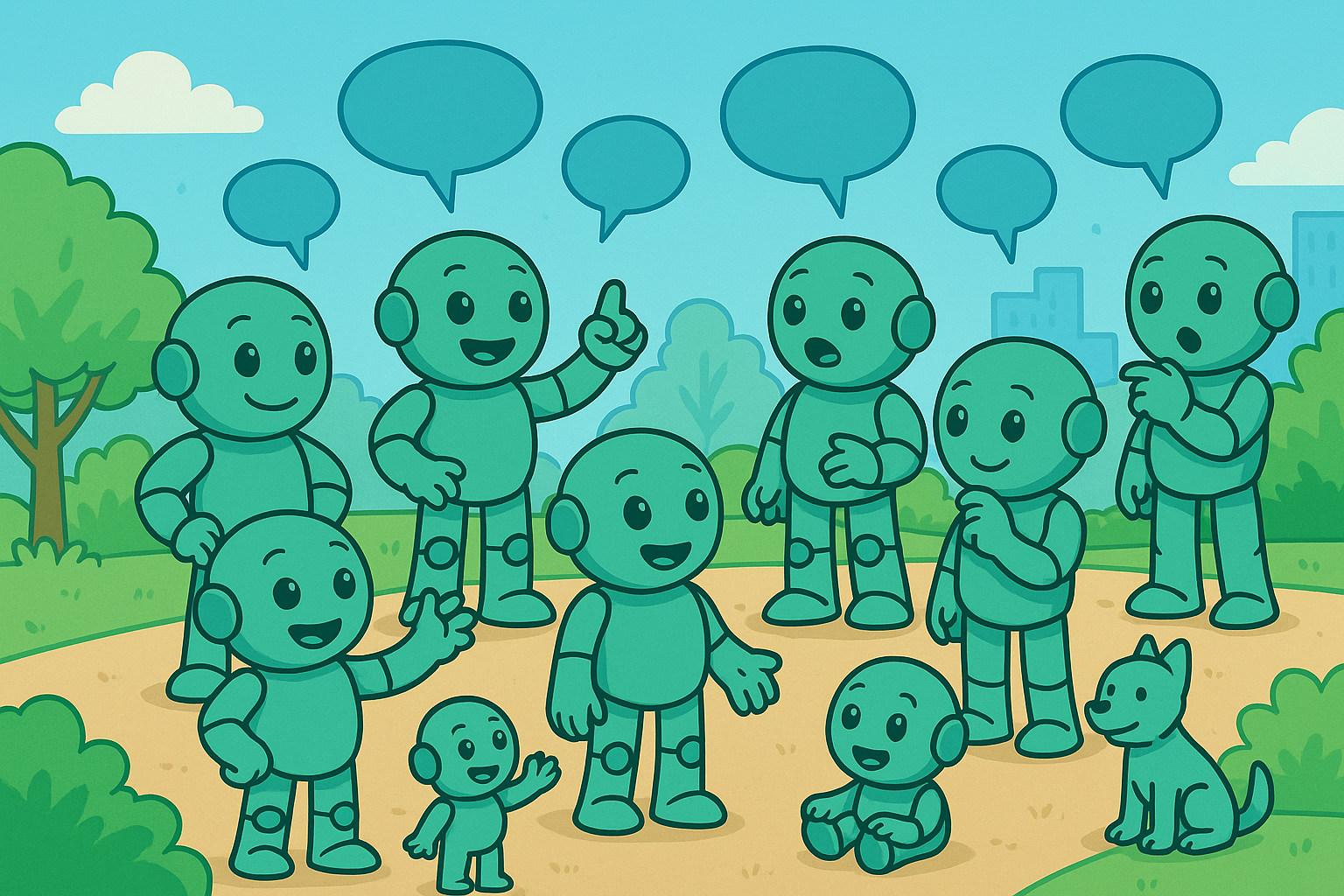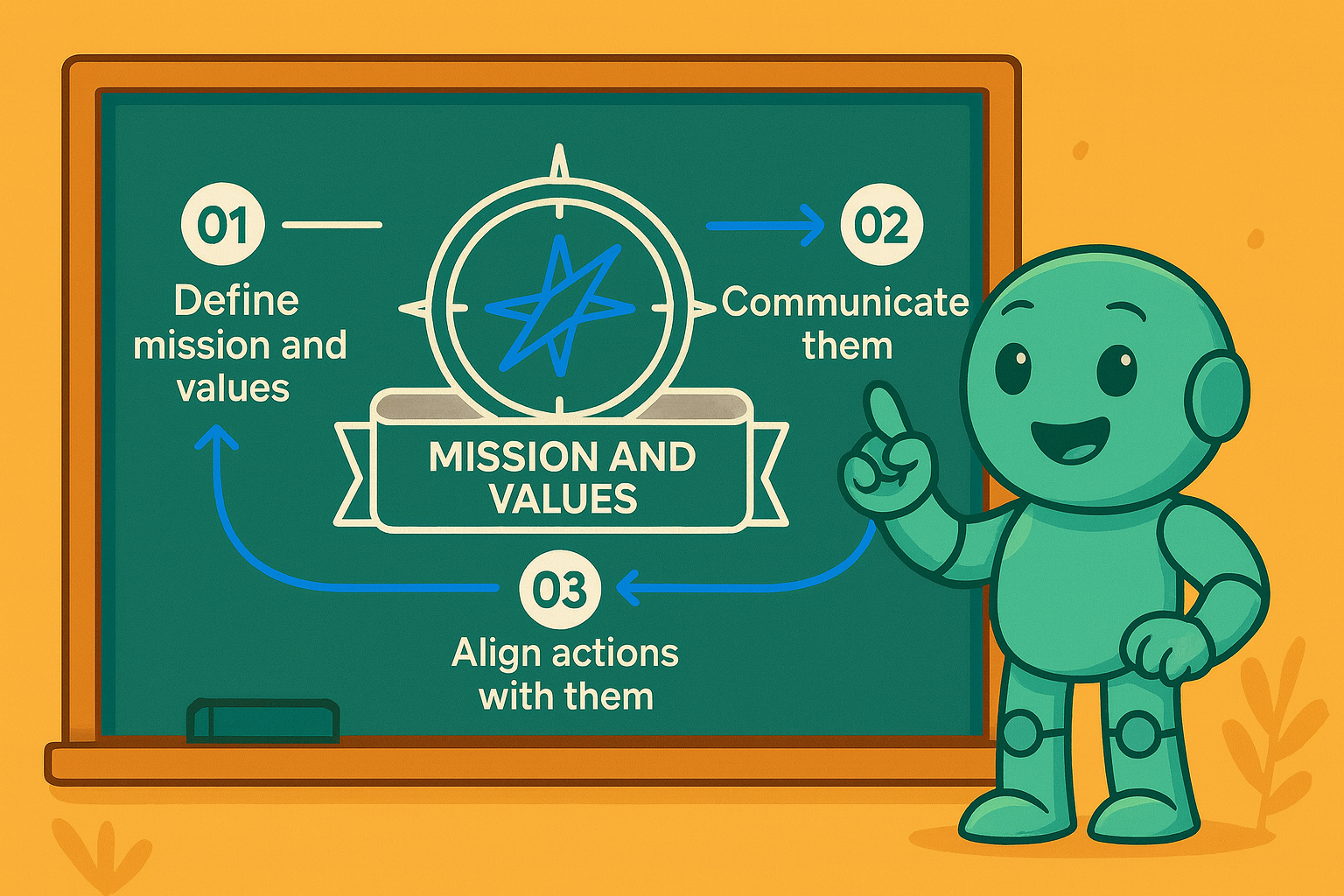How to Build a Brand Identity: Create a Memorable Brand
Building a brand identity is all about taking your company's core strategy — your mission, your values, your unique personality — and turning it into something people can actually see, hear, and feel. It’s the art of creating a consistent look, feel, and voice through your logo, colours, messaging, and overall vibe that shapes how the world perceives you.
What Is a Brand Identity Really?

So many entrepreneurs get this wrong. They think a brand identity is just a slick logo and a cool color palette. While those visual elements are definitely part of the equation, they're just the surface. A truly powerful brand identity goes much deeper. It’s the complete sensory experience of your brand, the thing that forges a real connection with people on an emotional level.
Think of it as your business's personality brought to life. It’s what makes you instantly recognizable and memorable in a crowded marketplace. This identity isn't an accident; it's the result of every deliberate choice you make, from the font on your website to the tone of a customer service email.
Beyond Visuals: The Strategic Foundation
Before a single pixel is pushed or a colour is chosen, you have to lay the groundwork. This is the strategic foundation—the "why" behind your brand's "what." A strong identity is always built on a crystal-clear understanding of a few core ideas.
To ensure every creative choice is intentional and authentic, you need to be able to answer these fundamental questions first.
Before diving into the creative process, it's essential to solidify the strategic pillars that will support your brand. The following table outlines these core components, providing a framework to guide your thinking.
Core Components of Brand Identity
| Component | Description | Key Question to Answer |
|---|---|---|
| Mission | The fundamental purpose of your company beyond making money. | Why do we exist? |
| Values | The non-negotiable principles guiding your actions, culture, and decisions. | What do we stand for? |
| Personality | The human characteristics and traits that define your brand's voice. | If our brand were a person, what would they be like? |
| Positioning | Your unique place in the market and what sets you apart. | What makes us the better choice? |
Having clear, honest answers to these questions is non-negotiable. Without this clarity, your brand identity will feel hollow and disconnected, ultimately failing to build the trust you need with your audience.
A brand identity isn’t just about looking good; it's about communicating meaning. It’s the bridge between your business strategy and your customer's perception. Every element should work together to tell a consistent and compelling story.
The Growing Importance of Intentional Design
In today’s incredibly crowded market, having a well-defined brand identity isn't a "nice-to-have" anymore. It's essential for survival and growth. It becomes a powerful business asset that drives recognition, loyalty, and, yes, revenue.
You can see its rising importance just by looking at the numbers. The global market for corporate identity design was valued at USD 8.41 billion in 2023 and is expected to rocket to USD 14.26 billion by 2032. As you can read in the full corporate identity market analysis on DataIntelo.com, this trend shows companies are finally moving beyond just getting a logo and are embracing a much more strategic approach.
This strategic blueprint you create—the one that blends your mission, values, and market position—will guide every single decision you make from here on out. It’s how you ensure your brand doesn't just grab attention but builds a genuine connection that turns casual customers into lifelong fans.
Defining Your Core Brand Strategy
A strong brand isn't something you just stumble upon. It’s built, piece by piece, on a foundation of deliberate strategy. Before you ever start dreaming up logos or picking out color palettes, you have to look inward and figure out what your business truly stands for. This is where you find your "why."
Too many companies slap a generic mission statement on their website and call it a day. But a real strategy goes much deeper than that. It’s about making conscious choices that make your brand feel authentic and forge a real connection with the people you’re trying to serve.
This strategic compass, shown below, illustrates how your mission and values should be the North Star for every other branding decision you make.

As you can see, a solid brand identity always starts with that central, guiding purpose. Everything else radiates outward from there.
Know Your Audience and the Competitive Landscape
The first real step in this process is to stop making assumptions and start doing your homework. You need to get crystal clear on who your ideal customers are—not just their age and location, but what truly drives them, what keeps them up at night, and what they aspire to achieve.
Getting this right involves a few practical steps:
- Talk to people. Run surveys and conduct interviews with potential customers. Ask them about the brands they love and, more importantly, why they love them.
- Become a digital anthropologist. Lurk in the online communities where your target audience hangs out. What are their biggest complaints? What kind of slang or inside jokes do they use?
- Scope out the competition. Take a hard look at your competitors' messaging and visual identity. What are they nailing? And where are the glaring gaps you can fill?
This research is how you uncover your unique selling proposition (USP). It’s that one thing you offer that nobody else does, making you the undeniable choice for your specific slice of the market.
A brand isn’t what you say it is. It's what your customers tell their friends it is. Your strategy is the backstage work you do to shape that perception from the inside out.
Define Your Mission and Core Values
Armed with a deep understanding of your audience, you can now define your brand’s internal compass. This isn't just fluffy PR speak; these are the guiding principles that will inform every single decision your business makes.
Your mission is your reason for existing beyond just turning a profit. What impact do you want to have? For a sustainable fashion brand, a mission might be, "To make ethical fashion accessible without sacrificing style."
Your core values are the non-negotiable beliefs that dictate how you operate. These could be principles like:
- Radical Transparency
- Unwavering Quality
- Customer-Led Innovation
- Community Empowerment
These values shape everything from your company culture and product development to the way you handle customer service emails. They are the backbone of your brand's authenticity.
Carve Out a Distinct Brand Personality
If your brand walked into a room, who would it be? Answering this question helps you define your brand personality—the set of human traits that makes your brand relatable and memorable. This personality directly influences your brand’s voice and tone.
Think about these archetypes as a starting point:
- The Sage: Authoritative and wise, a trusted source of knowledge (think Google).
- The Jester: Playful, funny, and doesn't take itself too seriously (like Old Spice).
- The Hero: Inspiring and courageous, focused on overcoming big challenges (Nike is the classic example).
- The Nurturer: Caring, compassionate, and supportive (like Johnson & Johnson).
Choosing a personality ensures your communication stays consistent, whether it's a quick tweet, a detailed product description, or a customer support chat. It’s how you go from being a faceless corporation to a brand that people feel like they actually know. This strategic choice is also a massive influence when it’s time to choose a brand name that drives recognition.
The shift toward prioritizing strategy is clear in spending trends. By the end of 2023, more than 75% of global businesses planned to invest more in their brand strategies than in physical infrastructure. Today, digital branding eats up about 60% of all global marketing budgets. This data highlights a fundamental truth: in a noisy market, a clear, well-defined strategy isn't just nice to have—it's the most valuable asset you can build.
Crafting a Memorable Visual Identity

This is where your brand strategy stops being an abstract concept and starts to become something real and tangible. All the deep work you've done on research, positioning, and personality now gets its face—the visual language that will speak for you.
A strong visual identity isn’t just about looking good. It’s about communicating your core message in an instant, without a single word. Think of it as your brand's silent ambassador. It’s what catches someone's eye on a crowded shelf, in a busy social media feed, or on a business card. Long before they read your mission statement, they’ve already formed an impression.
Our job here is to move beyond subjective taste ("I just like blue") and into strategic design ("This shade of blue conveys trust and stability, which is exactly what our brand is about"). Let's break down the key pieces that turn those big ideas into a cohesive visual system people will actually recognize and remember.
Designing a Meaningful Logo
Your logo is often seen as the cornerstone of your visual identity, but I’ll let you in on a secret: it shouldn’t be your first creative decision. A powerful logo needs to grow directly out of your established brand strategy. The best ones are simple, versatile, and manage to capture the essence of your brand in a single mark.
You've got a few different paths you can take here, and the right choice depends on your name and your market.
- Wordmarks: These are logos built from your full business name, like Google or Coca-Cola. They're a fantastic choice for new companies that need to build name recognition from scratch.
- Lettermarks: This is a streamlined approach using initials, like HBO (Home Box Office) or NASA. It’s a smart move for businesses with long or hard-to-pronounce names.
- Icons or Symbols: Think of the Apple logo or the Nike swoosh. These are incredibly powerful but require serious brand equity to stand alone without the company name.
- Combination Marks: This is the best of both worlds, pairing a wordmark with an icon, like Spotify or Adidas. It gives you incredible flexibility, allowing you to use the elements together or separately as needed.
Remember, your logo has to work everywhere—from a tiny favicon in a browser tab to a massive billboard. That means it must be effective at any size and still look good in a single color. An overly complex logo will just turn into a smudge when scaled down. While a great name is the foundation, and you can find solid advice on how to decide on a company name elsewhere, the logo is what makes that name stick visually.
A logo is not your brand, nor is it your identity. Logo, identity, branding—all have different roles, that together, form a perceived image for a business or product. Your logo is the quickest, most immediate visual representation of that system.
Choosing an Emotionally Resonant Color Palette
Color is a psychological shortcut. It’s one of the most potent, non-verbal tools in your branding toolkit. The right palette can immediately signal your brand's personality—be it energetic and bold, calm and trustworthy, or luxurious and sophisticated. In fact, research shows that using a signature color can boost brand recognition by up to 80%.
The key is to think of your colors as a system, not just a random collection you like.
- Primary Colors: Start with one to three main colors. These will be the most prominent and should be a direct reflection of your brand's core personality.
- Secondary Colors: Next, choose two to four complementary colors. You'll use these for accents, highlights, and differentiating content on your website or in marketing materials.
- Neutral Colors: Finally, round it out with neutrals like white, black, grey, or beige. These are absolutely essential for backgrounds, text, and creating breathing room in your designs.
For example, a fintech company trying to project security and authority might lean into a deep, stable blue as its primary color. On the other hand, a wellness brand focused on natural ingredients would probably find its voice in earthy greens and muted, calming pastels. Your palette isn't just decoration; it's a strategic communication device.
Selecting Typography That Speaks Volumes
Believe it or not, fonts have personalities, too. The typography you choose says a great deal about your brand's voice before anyone reads a single word. A traditional serif font can feel authoritative and classic, while a clean sans-serif font often reads as modern, clean, and approachable.
Just as with colors, the goal isn't to collect a bunch of fonts you like. The goal is to build a clear and functional hierarchy. For most brands, a simple and effective system involves just two or three typefaces:
- A Primary Font: This is for your headlines and major titles. It's your chance to be a bit more expressive and choose a font with some real character.
- A Secondary Font: This one is for your body copy and longer paragraphs. Legibility is everything here. It must be easy to read, even at smaller sizes.
- An Accent Font (Optional): You might use a third font for specific calls-to-action or to highlight a special quote. Use this one sparingly.
The real magic happens with consistency. Once you’ve selected your fonts, use them religiously. This typographic discipline is what makes your brand look polished and professional across your website, social posts, and presentations. It builds a subtle but powerful sense of familiarity and reliability in your audience’s mind.
Developing Your Authentic Brand Voice
How your brand sounds is just as important as how it looks. A killer visual identity might get you noticed, but your brand voice is what forges a real connection. This voice is the consistent personality that should shine through in every single word you publish, from a punchy ad headline to a thoughtful customer support email.
I like to think of it this way: your visuals are the outfit, but your voice is the actual conversation. Nail this, and you'll find a communication style that's not only distinct but feels completely true to who you are. It’s the secret to shifting from a faceless company to a brand people feel they genuinely know and trust.
Pinpointing Your Brand Voice and Tone
So, what’s the difference between voice and tone? Your brand voice is your fixed personality—it doesn’t change. Your tone is the emotional inflection you apply to that voice in different situations.
Your voice should always be consistent, but your tone needs to be flexible. For example, you might adopt a witty, high-energy tone on social media. But when you’re handling a customer complaint, that tone would shift to be more empathetic and reassuring. The core personality, the voice, remains the same underneath it all.
A great place to start is by mapping your voice on a few simple spectrums. Where does your brand land on these traits?
- Funny vs. Serious: Are you a bit of a class clown, or do you get straight to the point?
- Formal vs. Casual: Do you prefer professional, buttoned-up language, or are you more comfortable with conversational slang?
- Respectful vs. Irreverent: Do you play by the rules or enjoy breaking them with a wink?
- Enthusiastic vs. Matter-of-fact: Are you always fired up and passionate, or more calm and direct?
Answering these questions gives you a clear framework, preventing your brand from sounding erratic or unpredictable. That consistency is the foundation of trust. In fact, a study from Lucidpress found that consistent brand presentation can boost revenue by a staggering 33%.
Crafting a Compelling Brand Story
Your brand story is so much more than a paragraph tucked away on your "About Us" page. It’s the narrative that connects all the dots for your audience, humanizing your business and giving people a genuine reason to care.
What makes a story stick? It usually answers a few core questions in a compelling way:
- The "Why": What was the spark? What problem or passion got this whole thing started?
- The Struggle: What hurdles did you have to overcome? Don't be afraid to be vulnerable here—it builds connection.
- The Mission: What is the ultimate purpose your brand serves for the people who buy from you?
A powerful brand story gives your audience something to root for. It transforms a simple purchase into a meaningful exchange, making customers feel like they're part of your journey.
Your brand voice isn't what you say, but how you say it. It's the consistent personality that turns one-time buyers into a loyal community who believe in what you stand for.
From Ideas to Actionable Messaging Guidelines
Once you've defined your voice and story, you have to write it all down. Without clear, documented guidelines, that carefully crafted personality will start to unravel as different people on your team apply their own interpretations. This is where messaging guidelines become your most valuable player.
This document doesn't need to be a 50-page novel. Simple is almost always better. Think of it as the single source of truth for anyone creating content for your brand—from marketing and sales to your customer service reps.
A truly practical set of guidelines should include these key parts:
| Component | Description | Example |
|---|---|---|
| Brand Voice Summary | A few sentences describing the overall personality. | "We're witty, but never mean; smart, but not stuffy. We're the knowledgeable friend who makes complex topics feel simple and fun." |
| Tone of Voice Examples | How the voice adapts to different scenarios. | Social Media: Use emojis, slang, and humor. Support Emails: Be empathetic, clear, and solution-focused. |
| Key Messaging Points | The 2-3 core ideas you always want to reinforce. | "Quality is non-negotiable." "Designed for creative professionals." "Sustainable from start to finish." |
| Words to Use/Avoid | A simple do's and don'ts list for language. | Use: "Collaborate," "Create," "Simple." Avoid: "Utilize," "Synergy," "Cutting-edge." |
This simple framework ensures that every piece of communication—from a tweet to a product description—sounds like it came from the same place. This isn't just about looking good; it's about building a predictable, reliable, and ultimately unforgettable brand experience.
Bringing Your Brand Identity to Life
You've done the hard work. The strategy is sharp, the visuals are stunning, and the messaging is on point. But a brilliant brand identity is just a well-designed PDF until you release it into the wild. This is where the rubber meets the road—the moment your carefully crafted plans become a real-world experience.
A successful launch isn't just about flipping a switch. It's a thoughtfully orchestrated process, starting with your own team and then rolling out to your customers. Every single touchpoint, from the look of your website to the feel of your packaging, needs to sing the same song. This is how you turn abstract concepts into tangible assets that build real recognition and trust.
The Internal Rollout: Your Team Gets the First Look
Before you show off your new look to the world, you have to get your own people fired up about it. Your employees are your most critical brand ambassadors, and their buy-in is absolutely essential. A team that's confused or uninspired simply can't represent the brand with the passion it deserves.
So, how do you get them on board? Plan an internal launch event. Don't just send out a memo—make it an experience.
- Explain the 'Why': Walk everyone through the strategy. Show them how this new identity connects directly to the company’s mission, its values, and where you're all headed.
- Show Off the Goods: This is the fun part. Unveil the new logo, the color palette, and the key messaging. Give them a tour of the official brand style guide so they know how to use everything correctly.
- Equip Them for Success: Hand out some fresh branded swag—think t-shirts, mugs, or high-quality notebooks. It’s a small gesture that goes a long way in building pride and a sense of shared ownership.
When your team truly understands the story behind the brand and feels like they’re part of it, they’ll champion it with an enthusiasm you just can’t fake.
The internal launch is your first and most important test. If you can't sell your new brand identity to the people who work for you, you'll have an even harder time selling it to your customers.
Applying Your Identity to Essential Assets
With your team aligned and excited, it’s time to push the new identity out across all your customer-facing channels. Consistency is everything here. It’s what builds a recognizable and professional presence. To get the biggest bang for your buck, focus on the most critical assets first.
Here’s a practical checklist to get you started:
- Your Website: This is your digital storefront. Overhaul your homepage, product pages, and blog with the new logo, colors, fonts, and brand voice.
- Social Media Profiles: Swap out your profile pictures, cover photos, and bios on every platform. Your next 10 posts should be a masterclass in the new visual and verbal style.
- Packaging and Products: If you sell physical goods, the unboxing experience is a massive branding opportunity. Make sure your new packaging perfectly reflects the new identity.
- Marketing and Sales Materials: Every template needs an update. This means everything from email signatures and newsletters to sales decks and business cards.
Applying your identity this thoroughly ensures that no matter where a customer bumps into your brand, they get the same seamless and impressive experience.
Staying Consistent and Evolving with Purpose
Building a brand identity isn’t a one-and-done project. Far from it. The real work lies in the day-to-day discipline of maintaining it and the wisdom to evolve it thoughtfully over time. It requires a genuine commitment to protecting the integrity of your identity system. For a deeper look at this long-term thinking, you can explore more about creating a lasting brand identity and how to reinforce these principles.
A great habit to get into is conducting regular brand audits—maybe once a year. This is your chance to review all your assets, hunt down any inconsistencies, and check if your identity still clicks with your audience and supports your business goals. As your company grows, your brand will inevitably need to adapt. The trick is to make these changes strategically, building on the strong foundation you’ve already laid, not tearing it down to start over.
This long-term perspective is what separates fleeting brands from iconic ones. It’s no surprise the global branding agencies market was valued at USD 5.2 billion in 2023 and is projected to hit USD 8.7 billion by 2032. As you can learn from market research on DataIntelo.com, this growth is fueled by businesses realizing that brand management is a vital, ongoing process—not just a one-off creative sprint.
Answering Your Brand Identity Questions
Even with the best game plan, building a brand identity can feel like navigating a maze. It’s a big deal, and naturally, questions pop up along the way. Let's tackle some of the most common ones I hear from companies, whether they're just starting out or rethinking their entire image.
How Long Does It Take to Build a Brand Identity?
This is the big "how long is a piece of string?" question, but I can give you some realistic timelines based on what I've seen. The answer really hinges on your company's size and the project's scope.
For a scrappy startup trying to get the fundamentals locked in, you could be looking at a 4-6 week sprint. It's intense, but it gets the core job done.
On the other hand, a full rebrand for a larger, established business is a much deeper dive. These projects often span 6 to 12 months, sometimes even longer. The work usually breaks down into a few key stages:
- Strategy & Research: 2–4 weeks
- Visual & Messaging Development: 4–8 weeks
- Implementation Across All Assets: 4+ weeks
The one area you absolutely cannot afford to rush is the initial strategy and research. A wobbly foundation guarantees a brand identity that doesn't connect, which always costs more time and money to fix later on.
What Is the Difference Between Brand, Branding, and Brand Identity?
These three terms get thrown around a lot, often interchangeably. But they're not the same, and knowing the difference is crucial for doing this work effectively.
Here’s a simple way to think about it:
- Brand: This is what people think and feel about you. It's your company's reputation, the gut feeling someone gets when they hear your name. It’s intangible, and while you can’t control it directly, you can absolutely influence it.
- Brand Identity: This is your toolkit for influencing that perception. It’s all the tangible things we’ve been talking about—your logo, color palette, typography, voice, and messaging. It’s the concrete expression of your brand.
- Branding: This is the action of using your brand identity. It's the disciplined, ongoing work of applying your style guide consistently across every single touchpoint, from your website and social media to your packaging and customer service emails.
To put it simply: Your brand is the reputation, your brand identity is the toolkit, and branding is the work you do with that toolkit.
How Often Should I Update My Brand Identity?
There’s no hard-and-fast rule here. The goal isn't to change for the sake of change, but to evolve thoughtfully. A smart move is to do a quick internal brand audit every year. Just a simple check-in: Does our identity still feel right? Does it align with where the business is headed?
For most companies, a minor refresh every 3–5 years is a good cadence. This isn't a total overhaul; it’s more about subtle tweaks. Maybe you update your secondary color palette or switch to a more modern typeface to keep things from looking dated.
A complete rebrand, however, is a massive strategic move. You only pull that trigger when something fundamental has changed—you're pivoting your business model, chasing a completely new audience, or you've simply outgrown your old identity.
Can I Build a Brand Identity on a Small Budget?
Absolutely. A powerful brand identity comes from clarity and consistency, not from a massive budget.
If your funds are tight, focus your money and energy where it counts most: strategy. You can do much of this foundational work yourself. Get laser-focused on your audience, hammer out your core values, and really nail your unique voice.
When it comes to the design itself, get resourceful. You can find talented freelance designers on platforms like Upwork or Fiverr who won't break the bank. Another route is to find a high-quality design template and customize it to fit the strategy you’ve already defined. A simple, well-thought-out design used consistently will always beat an expensive, inconsistently applied one.
Ready to find the perfect name that anchors your new brand identity? The naming journey starts here. NameRobot offers a powerful suite of tools, from AI-assisted generators to in-depth trademark checks, ensuring your brand name is not only creative but also market-ready. Start building your brand with NameRobot today.















